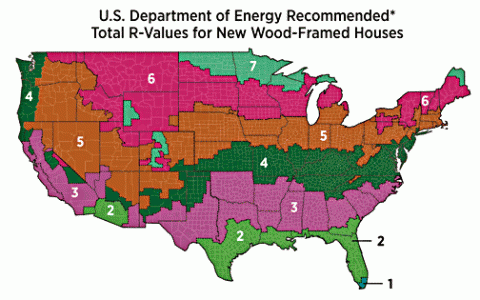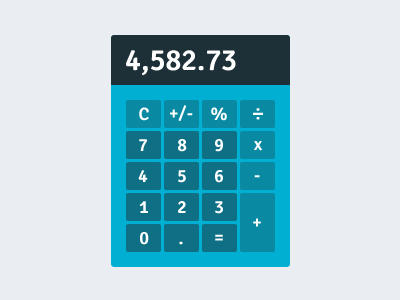Figuring out the cost and other details of an insulation project is difficult. Knowing where to start, and how to discern quality information online will help immensely. Unfortunately, Googling things like “insulation calculator” results in a flood of all sorts of calculators from various sources. It can be overwhelming to sift through, and a majority of top results are geared specifically toward problematic approaches like outdated fiberglass insulation for home improvement projects. If you don’t yet know whether or not you’ll even go with fiberglass, let alone details like how many rolls you might need, these calculators are often not helpful to at all. Let’s take a look at the two most helpful factors that you should focus on at this stage:
- R-value comparison
- Cost comparison
Comparing Insulation R-Values
When comparing the r-value of different insulation types and how installing them will affect your home, you need to consider a combination of factors and their potential benefits. The creators of most insulation r-value calculators are either hardware stores or insulation manufacturing companies. This means they usually only calculate the insulation needed for their own brand. They will usually provide limited results outlining their products’ estimated performance if it were installed in the location and dimensions of your home. For someone just starting their research, these calculators ask the wrong questions, are biased, and aren’t very helpful.
There’s a better way to calculate meaningful answers. You will need to gather some data first. We have broken down everything you need to know into three steps. Each is explained below. By the time you’re done, you’ll have a strong set of answers, based on real data, about any type of insulation you’re considering.
We have relied on recommendations and data from the U.S. Department of Energy throughout. They are a great resource, especially for the first two steps of the process.
Step One: Find your R-Value by Climate Zone
First, you will need to find the number for your r-value climate zone, which can be located using the following map from the Department of Energy:

For example, if you live in Boulder, CO, you would be classified as climate zone 5.
Step Two: Match your Climate Zone Number to the D.O.E. Recommended R-values
Next, you would match your climate zone with a table outlining recommended r-values by climate zone, using this table (also from the Department of Energy):
| Suggested R-Value by Climate Zone | ||||||
| Location | Heat Type | Attic | Wall | Floor | Crawl Space | Basement Wall |
| Zone 1 | Natural Gas | 38-49 | 13 | 13 | 13 | 11 |
| Oil Furnace | 38-49 | 13 | 13 | 13 | 11 | |
| Electric Furnace | 38-49 | 13 | 13 | 13 | 11 | |
| Electric Baseboard | 38-49 | 13 | 13 | 13 | 11 | |
| Heat Pump | 38-49 | 13 | 13 | 13 | 11 | |
| LPG Furnace | 38-49 | 13 | 13 | 13 | 11 | |
| Zone 2 | Natural Gas | 38 | 13 | 13-19 | 13 | 11 |
| Oil Furnace | 38 | 13 | 13-19 | 13-25 | 11 | |
| Electric Furnace | 38-49 | 13 | 19-25 | 25 | 11 | |
| Electric Baseboard | 38-49 | 13 | 13-25 | 13-25 | 11 | |
| Heat Pump | 38 | 13 | 13-19 | 13 | 11 | |
| LPG Furnace | 38-49 | 13 | 19-30 | 25 | 11 | |
| Zone 3 | Natural Gas | 30-38 | 13 | 13-19 | 13-25 | 11 |
| Oil Furnace | 38 | 13 | 13-19 | 13 | 11 | |
| Electric Furnace | 38 | 13 | 13-19 | 13-25 | 11 | |
| Electric Baseboard | 38 | 13 | 13-19 | 13 | 11 | |
| Heat Pump | 30-38 | 13 | 13 | 13 | 11 | |
| LPG Furnace | 38-49 | 13 | 13-30 | 13-25 | 11 | |
| Zone 4 | Natural Gas | 38-49 | 13 | 25-30 | 25 | 11 |
| Oil Furnace | 49 | 13 | 30 | 25 | 11 | |
| Electric Furnace | 38-49 | 13 | 25-30 | 25 | 25 | |
| Electric Baseboard | 49 | 13 | 30 | 25 | 11 | |
| Heat Pump | 38-49 | 13 | 13-25 | 13-25 | 11 | |
| LPG Furnace | 49 | 13 | 30 | 25 | 11-25 | |
| Zone 5 | Natural Gas | 38 | 13 | 25 | 25 | 11 |
| Oil Furnace | 49 | 13 | 30 | 25 | 11-15 | |
| Electric Furnace | 49 | 13 | 30 | 25 | 25 | |
| Electric Baseboard | 49 | 13 | 30 | 25 | 11 | |
| Heat Pump | 38 | 13 | 30 | 25 | 11 | |
| LPG Furnace | 49 | 13 | 30 | 25 | 25 | |
| Zone 6-8 | Natural Gas | 49 | 13 | 30 | 25 | 25 |
| Oil Furnace | 49 | 13 | 30 | 25 | 25 | |
| Electric Furnace | 49 | 13 | 30 | 25 | 25 | |
| Electric Baseboard | 49 | 13 | 30 | 25 | 25 | |
| Heat Pump | 49 | 13 | 30 | 25 | 25 | |
| LPG Furnace | 49 | 13 | 30 | 25 | 25 | |
So for example: If you are located in Zone 5 of the climate zone chart, you would find Zone 5 on the suggested r-values chart. From there you would be able to further determine what r-value is needed based on the heat type of your home and which area you are looking to insulate. If you’re looking for the best way to insulate the attic of an electric furnace heated home in Zone 5, an r-value of 49 is recommended.
Step 3: Calculate the Thickness of Insulation Needed
The last step, which does require light calculation, is to determine what thickness of each type of insulation you would need.
To perform your calculation, you’ll need to find the r-value per inch for every insulation type you are considering. Most of the relevant types and their associated r-value/inch are listed in the following table:
| Insulation Type R-Values by Application | |
| Material | R-Value/inch |
| Closed-cell Spray Foam | 6.0 – 6.5 |
| Open-cell Spray Foam | 3.5 – 3.6 |
| Polyisocyanurate Board (foil-faced) | 5.6 – 8.0 |
| Polyurethane Board | 5.5 – 6.5 |
| Polystyrene Board | 3.8 – 5.0 |
| Blown-in Cellulose (attic) | 3.2 – 3.7 |
| Blown-in Cellulose (wall) | 3.8 – 3.9 |
| Blown-in Mineral Wool (attic) | 3.1 – 4.0 |
| Blown-in Mineral Wool (wall) | 3.1 – 4.0 |
| Mineral Wool (batt) | 3.1 – 3.4 |
| Blown-in Fiberglass (attic) | 2.2 – 4.3 |
| Blown-in Fiberglass (wall) | 3.7 – 4.3 |
| Fiberglass (batt) | 3.1 – 3.4 |
The calculation required by you is simple: Divide your recommended r-value by the r-value per inch of each of the insulation types you are comparing. Continuing with the previous example, the attic of a Zone 5 electric furnace heated home is recommended to be insulated at an r-value of 49. This means your attic would require around 11.4 to 22.3 inches of blown-in fiberglass insulation to be at the recommended level of energy efficiency. In comparison, the same attic would only require about 7.5 to 8.2 inches of spray foam insulation to meet the same energy efficiency standard. It quickly becomes evident how big of a difference this can make! It may not be practical, or even be possible to attain your recommended r-value with certain forms of insulation if they can’t be applied or layered that thick. This would result in significant energy loss over time.
Comparing Cost
The second critical factor to consider is the comparison of various types of insulation’s upfront installation costs and cost over time. This is many people’s primary concern. Luckily, there are calculators available that will use the square footage of your home to estimate your upfront installation costs of each type of insulation, the cost of your monthly energy bills after installing said insulation, and the potential savings or loss over time. Many of these cost estimators focus on comparing various forms of insulation vs. fiberglass. This is because fiberglass is the most common material used to insulate homes. Fiberglass is also one of the least efficient insulators available on the market.
Here is a simple calculator that compares fiberglass and spray foam insulation. The cost difference over time in comparison to upfront cost is astonishing. Although installing spray foam insulation is up to three times more expensive than installing fiberglass, that cost difference usually is surpassed by energy savings within less than 4 years. And past the point that the benefits outweigh the extra upfront costs, the lower energy bills from having your home more efficiently insulated will continue to add up.
Comparing Added Equity to Your Home
Another factor that you may be looking for a calculator for is the comparison of how much market value the different insulation types add to your home. Unfortunately, there is no one size fits all comparison tool to find the best insulation. There’s no question that adding insulation to your home, no matter what type, automatically adds value. However, once you’ve done your research and calculations for the first two factors, you don’t even need a calculator to estimate which types of insulation would add the most value to your home. When searching for said calculator, you will come across many different sources that give you the same general rule of thumb: The higher r-value your insulation has, the more energy efficient your home will be. And the more energy efficient your home is, the higher value it will have.
Whichever option was the clearest when comparing r-value and cost effectiveness will more than likely be the best choice in terms of adding equity to your home. In our examples and across the board, spray foam insulation had the highest r-value per inch as well as the highest projected energy bill savings over time, making it the clear choice for the best investment to not only save you money per month but also add value to your home if you are looking to put it on the market in the future.
Sources mentioned in this article:

Leave a Reply